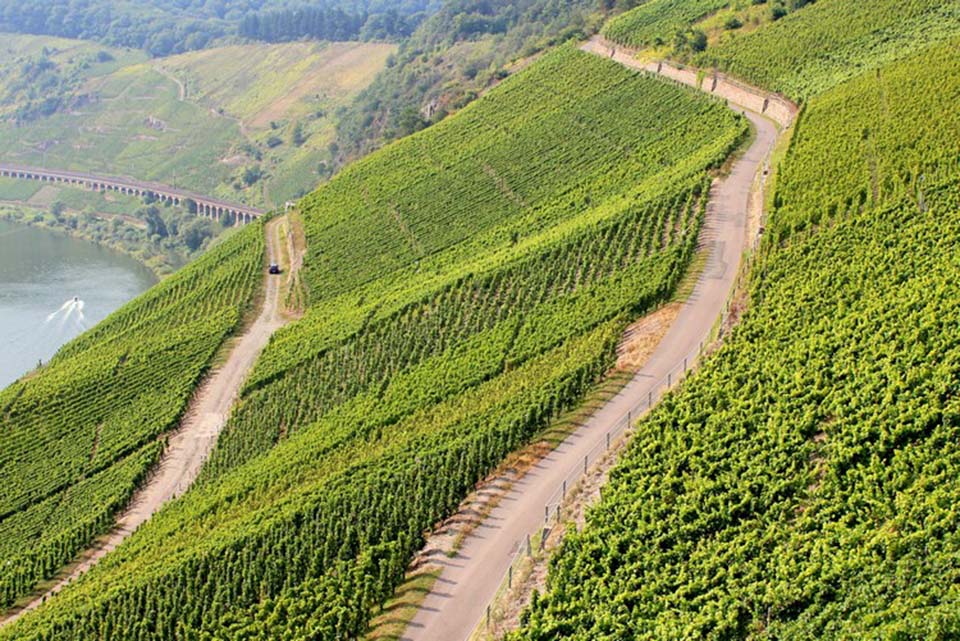
When I began college life in the 1960s, I knew nothing about wine. I used to buy a German brand known as Goldener Oktober largely because I liked the evocative name, and it came from somewhere called the St. Ursula Winery, which gave it a bit of ecclesiastical gravitas. It was a slightly sweetish blended white wine produced for the mass market but suited my immature palate. There were other similar brands; semi-sweet crowd-pleasers such as Black Tower, Devil’s Rock and Blue Nun which were all much the same Liebfraumilch-style drinks. These commercial wines are still manufactured in enormous quantities. The makers of Black Tower claim that their product has been Germany’s most successful wine brand for more than fifty years. These simple beverages were a good introduction for a wine novice, but I soon found the need to move on.
Perhaps the German wine industry shot itself in the foot with the introduction of all these commercial products in the 1960s. Even today, many people associate German wine with sweetish white plonk and forget that Germany traditionally produces high-quality premium wine. In 19th century England, many German wines sold for higher prices than top-quality Bordeaux.
The town of Hochheim am Main was the historical centre of the German wine trade. For years, the British referred to all German white wine as “hock” perhaps because the name Hochheim was beyond their linguistic capabilities. I can remember the word appeared on wine gums, which I used to chew when I was a child. Other children enjoyed gob-stoppers and enormous sticks of licorice, but I must have felt that wine gums lent me an air of quiet sophistication. The other kids probably thought I was a poncey little prat.
There are currently two major categories of German wine (1) basic table wine often described on the label as Tafelwein and (2) higher quality wines which are further divided into two categories. These are known as Qualitätswein (quality wine) and Prädikatswein (quality wine with special attributes). Prädikatswein is further divided into six categories in order of increasing sugar levels in the grape juice. I admit that this is a slight simplification, but I don’t want to bore you comatose.
The classic German white wine grape is the Riesling (REEZ-ling) and wine experts agree that German Riesling is among the world’s finest. Other grapes are grown of course, but Riesling remains the king. Or the queen, if you prefer. Riesling can be made in a wide range of styles depending on the sugar levels of the grapes, from bone dry to intensely sweet.
Riesling reaches its greatest expression in the Rhein and Mosel regions and especially in the Rheingau, an area near the river bank roughly between Eltville and Lorch. The Rheingau is home to Schloss Vollrads and Schloss Johannisberg, both of which have been making fine wine for over 800 years. You might be surprised to know that Germany also produces an increasing quantity of red wine. About a third of the vineyards are planted with red grapes, the most popular being the Spätburgunder, the German name for our old friend Pinot Noir.
The River Mosel rises in the Vosges mountains of Eastern France then meanders north through Luxembourg and Germany where it joins the Rhein at Koblenz. The Mosel is Germany’s third largest wine region and known for the steep sloping vineyards which overlook the river. These are some of the steepest vineyards in the world.
Few high-quality German wines find their way into Asia. Consumer taste has moved towards richer reds and fruity full-bodied whites, often relatively high in alcohol. German wines are sometimes the polar opposite, with more mineral qualities, and lighter in both body and alcohol. The Pattaya company Vines to Vino has a small selection of German wine, including a Riesling and a Pinot Noir from the trendy wine producer Weingut Cuba am Rhein. The finest selection of top-quality German wines is available from Wine Garage in Bangkok, which also offers a delivery service to Pattaya. You can find the company online and they’ll send their wine-list if you ask nicely.
Nollen Erben Riesling, 2021 (white), Mosel, Germany. Bt 649 @ Villa
Because of the northerly location, Mosel wines are usually crisp and light; low in alcohol and high in acidity. This one is a pale, straw colour with an attractive sweetish floral aroma with reminders of white flowers. After a few moments of air contact, the aroma of dried herbs came through. Even so it’s much less exuberant than its Australian cousins.
I remember tasting many Mosel wines on my German travels in the past and some of them were quite austere; completely dry with a razor-like acidity. However, this light-bodied wine is far less acidic than I was expecting. It seems to be crafted in a more popular style and although its dry, there’s a just a touch of residual sugar to balance the taste. It’s a zesty wine with a lively citrus palate, suggestions of green apple and a pleasingly long and dry citrus-like finish.
Wine from the Mosel is typically low in alcohol and at just 11.5% ABV, this clean and refreshing wine would make a good partner for light chicken meals, especially those that come with creamy sauce. It would work well with fish or soft cheese and the hint of sweetness would make it a good partner for many Thai dishes too.






